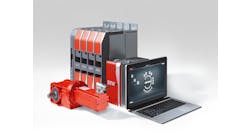Similar to the late, great Rodney Dangerfield, electricity gets no respect. It's in the same camp as every 24/7 support system from water/wastewater plants to motors in the process industries to first responders and healthcare workers—absolutely crucial, but totally invisible and taken for granted until their always-on services are interrupted.
Luckily for electricity at least, it's becoming less of an accounting afterthought thanks to easier, faster data processing, Internet networking, cloud-computing services and other types of digitalization. These forces are pushing power generation and distribution to become a cornerstone parameter, which can be monitored and managed, and contribute to greater efficiency and profitability for its users and consumers.
One of the best cases of this beneficial evolution is at BASF Agriculture Products North America and its herbicide plant in Beaumont, Texas, which recently revamped and expanded its onsite electrical supply and distribution system and controls. The company's initial objective was to increase the production capacity of one of the site’s operating units by 70%. This meant that the two existing 13,200 V – 480 V unit substations with 1,000-kVA transformers (four in total) needed to be replaced and upgraded with new 2,000-kVA transformers.
"The former electrical distribution equipment was built in the 1950s and '60s, and had reached the end of its useful life. It was no longer supported by the OEM and couldn't handle the added load requirements of the expansion project," says M. Lee Perry Jr., BASF electrical design engineer. "We had to design a new electrical distribution system and infrastructure that was also up to BASF standards. Built into this new substation equipment are intelligent electrical devices (IEDs), such as multifunctional, microprocessor-based relays and trip units, which are more reliable and repeatable, and can provide the data required for equipment health calculations."
Structure and infrastructure
Installed in 2015 and operational in 2016 with help from Schneider Electric, the new substation consists of a two-story, prefab, modular, climate-controlled structure, which is elevated 10 feet above grade to protect its components from the Gulf Coast's severe weather. Much of the former substation's equipment, such as its 13,200-V primary oil switches, transformers and 480-V low-voltage switchgear, were located outdoors. The new structure houses medium-voltage (MV) switchgear, low-voltage (LV) switchgear, LV motor control centers (MCC) and other critical auxiliary equipment. New items located outdoors include the liquid-filled transformers and 500-kW standby generator (Figure 1).
The new building and its intelligent electrical devices are interconnected and tied into two separate networks at the Beaumont plant. The first is a new Modbus TCP/IP Ethernet network that operations uses to connect the DCS that controls and monitors the process to the MCCs that runs the pumps, compressors, agitators and other equipment. The second network is also a new Modbus TCP/IP Ethernet network that the E&I maintenance team uses to monitor and control electrical distribution equipment, such as the MV and LV switchgear circuit breakers. The E&I maintenance network is linked to two HMI panels in the building and equipped with server, GPS satellite clock, Ethernet switches, digital I/O, fiber-optic patch panel and power monitoring software that manages the unit’s electrical network.
Figure 2: The Beaumont plant's power upgrade included adding a Modbus TCP/IP network to connect electrical distribution equipment, such as medium- and low-voltage components, HMIs panels, digital I/O, Ethernet switches and power monitoring software, which complements its existing Modbus TCP/IP network than links its intelligent MCCs, controllers, DCS, VFDs and other components. These network allow users to pull data from all power distribution devices to accelerate and improve decision-making. Source: Source: Schneider Electric and BASF
Each MCC lineup on the first network has a Magelis SCU HMI for local indication and monitoring of the motor starters, variable frequency drives (VFDs), and soft starts at the MCC. The overall unit process is managed by a Honeywell Experion DCS that was also upgraded during the project, and for a majority of the MCC loads, provides start/stop control via the Ethernet Modbus TCP/IP network. For a small percentage of the remaining loads deemed critical, start/stop control is hardwired using remote I/O panels installed outside the substation building. In both cases, all of the intelligent devices (overloads and VFDs) are networked via Ethernet and fiber to the DCS and controllers to provide a wealth of real-time data to the control room operators. The second network's HMI and controls also run PowerSCADA Expert (PSE) software from Schneider Electric (Figure 2).
"Our original equipment was all analog and hardwired, electromechanical relays, and couldn't have the same capability as what we use today," explains Perry. "For example, our IEDs have microprocessor-based relays for metering, intelligent overload handling, motor control and starting due to their reliability and because they can be networked to enable remote control, pull data, and monitor equipment health for trouble, failures or other events.
"IEDs have been available for 15-20 years, and we previously used them elsewhere because this is a common BASF practice. What's important now is that IEDS give users in the power generation and distribution field greater ability to control remotely and monitor equipment health. We can send signals via Modbus TCP/IP to open and close breakers, removing people from the equipment and outside the arc flash boundary."
Real-time data = optimal decisions
Perry reports the Beaumont plant's new substation, networking and smart devices are giving its operations more and better data for running their process applications and reacting to unusual conditions. Because each MCC has an HMI, operators and maintenance technicians can check if individual motors have tripped, and view real-time updates about power and voltage imbalances.
"Maintenance wants to keep processes running, and if they trip out, of course, they want to get them up and running again," says Perry. "However, they previously didn't know or have access to much data on trip conditions, but now they can see the whole history. We've moved this unit from the stone age to today, giving it and the site the ability to make better-informed decisions and do conditions-based management."
Once the new substation and support equipment was up and running, Perry explains his team started transferring existing and new power loads from the old substation to the new one. "The transfer went well, and the decision to implement and use intelligent MCCs saved about $500,000 by eliminating hardwired connections, and reducing commissioning and startup time," adds Perry. "The new overloads were easily added to the new network, and tied to the DCS/MCC panel, which uses Schneider Electric's SoMove software for programming overloads in MCCs and communications."
Likewise, the new network allows E&I maintenance staff to use Schneider Electric’s SoMove software to program and configure the overloads and VFDs at the MCCs. It also lets them adjust overload and VFD settings, monitor motor rotation checks, and resolve other issues quickly. In fact, technicians were able to checkout 10-20 motors per day, where they could only do about five daily with the old system. Specifically, current data is available immediately compared to manual hookups that used to take 15 minutes.
Finger on the power pulse
Beyond aiding immediate operations, BASF's new power distribution system with its IEDs, networking and software enable it to conduct helpful simulations. For instance, the DCS can participate in simulations on its HMI using data from the MCCs. Employing the same software used for MCC commissioning and checkout, users can send subsequent signals to overload relays to open or close contacts. This reduces time spent during commissioning and testing compared to running manual checks.
To extend gains from its digitalized IEDs and infrastructure, Perry adds BASF adopted Schneider Electric's EcoStruxure Asset Advisor software continuous monitoring IOT platform during 2017 because it could further tap into the networks to monitor equipment health and predict device failures. This project began by installing hardware on the existing networks to pull data from 30 critical assets for a six-month trial period. The hardware collects data parameters from the MCCs and power network, and delivers them though a cellular router to the cloud-based, encrypted Schneider Service Bureau and Connected Services Hub. Assets monitored during the trial period included four MV circuit breakers, four LV circuit breakers, 20 MCC overloads and/or VFDs, two UPS units and a 125-VDC battery charger.
Figure 3: To extend the gains from its digitalized IEDs and infrastructure, BASF adopted Schneider Electric's EcoStruxure Asset Advisor software to further tap into its network, monitor equipment health, and predict device failures; begin by linking two communication modules to 30 critical assets including four MV circuit breakers, four LV circuit breakers, and 20 MCCs or VFDs for a six-month trial period; and later expanded the project to 60-70 assets. Source: Schneider Electric and BASF
“As soon as the platform was implemented, we got emails from the service bureau saying we were overloading the VFDs associated with a critical part of the process," says Perry. "For a new substation, this notification surprised us and made us investigate to determine the root cause. After we found it, the E&I maintenance team used this insight to develop a short- and long-term action plan with operations to prevent failures of the drives.
Motor maintenance mystery
Just as its smart devices, network links and software let it solve power issues, the Beaumont plant also applies its newfound intelligence to assisting its motors.
The initial project examining 30 critical assets included seven MCC lineups, each with 20-40 motors, for a total of 240-250 existing or new motors that might be better optimized and maintained.
"The one earlier insight opened our minds about what else this platform could do, so we expanded the monitoring scope of the EcoStruxure system from 30 to 70 assets," adds Perry. "This let us monitor and provide health indexes for all their equipment, pull data every 15 minutes on a 24/7 basis, identify issues for all of them, and produce an overall report every six months.
"The first summary report covered pumps on one production train, and we found that one was running 20-30 times more often than the others, which may have indicated a balance issue. We also worked with Schneider Electric to streamline the reports and align them with industry and BASF maintenance practices. Instead of the typical three- or four-year preventative maintenance schedule, even if we weren't sure there was a problem, the summary report would say what most likely needed to be fixed—and what didn't. Now we have continuous monitoring data that gives us the an overall health index for the critical equipment. This affects and helps everything."
In the future, Perry speculates that digitalization and the Industrial Internet of Things (IIoT) will further improve operations at BASF and the Beaumont plant, especially by enabling power, operations, maintenance and other staffers to interact more frequently and effectively.
"We're having better interactions, dialog and relationships between operations and maintenance. Plus, maintenance now has the data it can bring to operations to make recommendations about changes that can help. There are more, 'Hey, we noticed...' conversations. For example, when the temperature goes up in the building, we get notifications to check the HVAC. Or when we receive notifications on incoming voltage supply issues, we can take this information to the utility, so they can determine and address the issue in their system."






